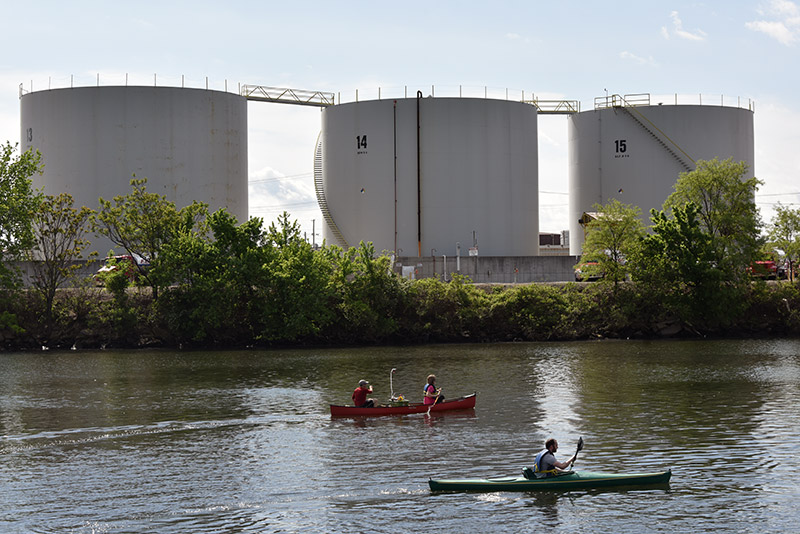
World Wetlands Day, which took place this weekend with a smattering of events across the country, is unlikely to reach the level of hoopla registered by Earth Day. Or most other celebrations, for that matter. But here at the College of Engineering, wetlands are celebrated in their own right through the work of engineers who monitor urban green infrastructure and the ability of restored, enhanced, or newly engineered wetlands to manage rainfall runoff.
Dr. Bita Alizadehtazi, a post-doc and research scientist in the Department of Civil, Architectural and Environmental Engineering (CAEE), studies the ecohydrology of engineered urban green spaces like wetlands. By coincidence, her country of origin happened to launch the first World Wetlands Day 18 years ago in the city of Ramsar on the Caspian Sea. It marks the adoption of the UNESCO Convention on Wetlands, known as the Ramsar Convention, on Feb. 2, 1971 by an intergovernmental environmental treaty.
Alizadehtazi received her AS from the Iran University of Medical Sciences and her BS from Shahid Beheshti University, both in environmental health. She received her MS in environmental engineering from Drexel’s College of Engineering, and her doctorate in environmental engineering in 2018 under the mentorship of Dr. Franco Montalto, an associate professor in CAEE. Alizadehtazi received Drexel University’s Graduate College Teaching Excellence Award in 2016. That year, there were over 500 eligible nominees from disciplines all across campus.
World Wetlands Day calls attention to the vital importance of wetland ecosystems as allies against climate change. They act as natural carbon sinks, absorb the impact of coastal storm surges, and even delay the onset of droughts. Yet one third of all wetlands have been lost over the last 45 years, with a rate of disappearance three times faster than the world’s great forests, according to the Ramsar Convention website. UNESCO lists more than 95 Ramsar Sites of International Importance, from Venice and its lagoons to the Delta du Saloum in Senegal to the Florida Everglades.

Research Scientist Bita Alizadehtazi
“Wetlands are periodically flooded landscapes with soils and vegetation specially adapted to those conditions,” said Alizadehtazi. “They provide habitat for a variety species of insects, animals, birds, and fish, but also filter the water, and can safely fill up with water during intense precipitation or high tides, key characteristics that help them to reduce flooding and improve water quality when they are integrated into developed landscapes.
“In urban landscapes, roofs, roads, and other impervious surfaces have many negative impacts on local, regional, and global energy and water balances. It is very costly to remedy these problems with engineered infrastructure systems. So, there is a growing interest in wetlands and other so-called nature-based approaches to make the urban landscape function better. Green infrastructure applies specifically to the green spaces that are designed to reduce runoff and flooding,” she said. “Wetlands, along with rain gardens, bioretention facilities, green roofs, and different kinds of porous pavements, help to hold rainwater in the landscape. This in turn reduces the number of problems you could get at the bottom of the hill and near the coasts.”
With other researchers in CAEE’s Sustainable Water Resource Engineering Lab, Alizadehtazi has been conducting post-construction monitoring in two different engineered wetlands in New York—one in the Bronx and one in Queens. She uses the field monitoring data to better understand how these two different systems function under a variety of rainfall events. Alizadehtazi is specifically interested in how wetland performance varies with different tributary areas, in different storms, and under different subsurface conditions.
The Bronx wetland is a lined system, installed on poor quality soils in a small sliver of land between a warehouse and the Bronx River. Prior to the wetland’s construction, runoff generated from the warehouse parking lot was discharged directly to the Bronx River. Now, the lined wetland receives runoff from the parking lot, where it is stored, filtered, and either slowly released to the river or evaporated. The Queens system is an unlined system. It is installed adjacent to Meadow Lake in an area with an extremely high water table, where it also receives parking lot runoff. The research question at this site is how the parking lot runoff can be infiltrated into the highly saturated local soils.
“In urban settings a larger fraction of pre-development natural systems has been destroyed, in comparison to rural or suburban regions,” said Alizadehtazi. “In these highly urbanized landscapes, each wetland is potentially very valuable. But we need to better understand the optimal ways of siting, designing, and operating them if we are to get the most benefit. That’s why monitoring different types of green infrastructure over long periods of time in different landscape settings is so important.
“You cannot just reproduce the same design over and over. Depending on where you are working, you may have different physical conditions, but also different needs and priorities – you might have contaminated or saturated soils at one location, or sand and nearby basements at another. We need to customize the wetland designs to these kinds of conditions, but only after we’ve studied what works and what doesn’t,” said Alizadehtazi.
“From my work thus far, I think that these kinds of nature-based approaches to managing urban water are doing their job quite well,” she added. “And that’s what we’re aiming for.”